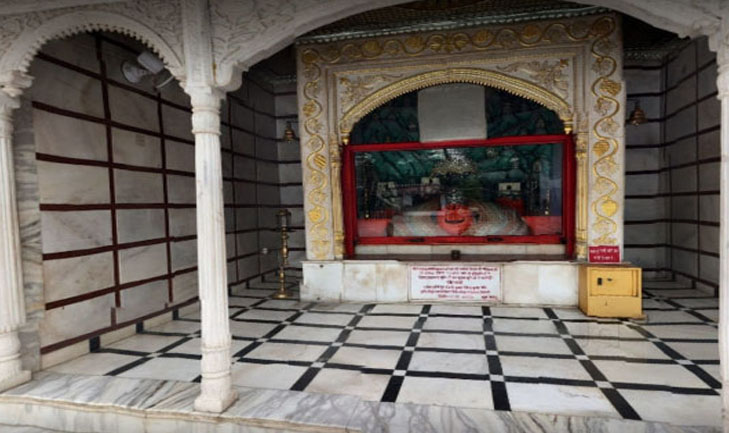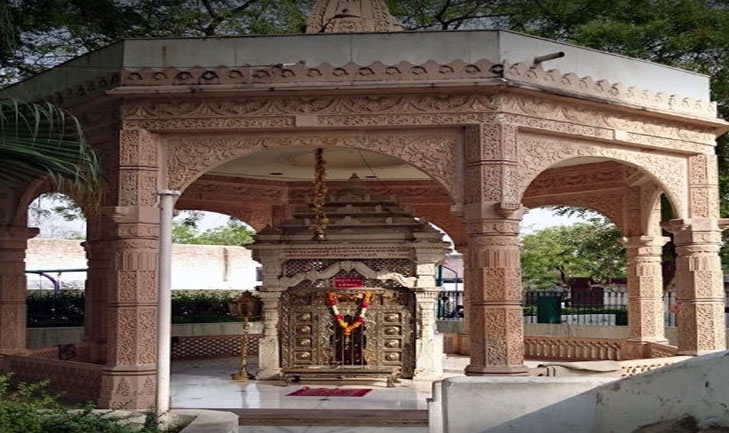Manidhari Jinchandra Suri Jain Tirth
Mehrauli, New Delhi
 |
The mere name inspires faith and reverence. There are few parallels in history, where a person accomplished so much encompassing various facets of life in such a short span of time. He was one of those rare men, who had a gem (Mani) in his forehead and therefore known as 'Manidhari'. A preacher of 'Sarva Dharma Sadbhava', he is worshipped and respected by Jains Hindus, Muslims and Sikhs alike.
Born 849 years ago (Vikram Samvat 1197) at Vikrampur (Jaisalmer-Rajasthan) to Seth Rasal and Delhan Devi, the boy Surya Kumar was a child prodigy. His inquisitiveness and brilliance was manifest to be visible to even laymen. His brilliant, logical mind, at tender age of six, came to the grips of the causes of eternal turmoil and griefs of mankind. Realising the causes and resultant pain, through his logical mind and clarity of thoughts, he searched for the panacea for eternal peace and bliss. He renounced the world, at the age of six in Samvat 1203 (1147 A.D.), after getting permission from his parents and was initiated to saint life (Jain Sadhu) by Yugpradhan Acharya Jindutt Suriji - himself a great propagator of Jain religion and crusader for social reforms, after initiation (Diksha), he was named Shri Jinchandra Suri. During his stay with Gurudev Jindutt Suriji, he studied Jain texts and scriptures and texts connected with other philosophical schools and religions, astrology, Mantra Vidya, Cosmology, metaphysics, theology etc. Having mastered it, he was appointed Acharya in Samvat 1205 (1149 A.D.) at the age of eight. At the young age o f 14 in Samvat 1211, the onerous responsibility of managing the affairs and directing the destiny of Jain Sangha fell on his young shoulders, which he bore with distinction. A great scholar, he authored many books and by his logic and pragmatism, he was able to clear many misconceptions and superstitions prevalent in the society at his time. He fought relentless for the social and religious reforms and was instrumental in giving a place of honour and dignity to every oppressed and unprivileged. He propogated the ideals of Ahimsa, religious tolerance, equality and universal brotherhood. Soon, his magnanimity and universal appeal of ideals endeared him not only to Jains, but even Hindus and Muslims became his disciples and followers and was popularly known among them as 'Dada Gurudev'. The fact that he was respected by Hindus and Muslims alike in those turbulent years speaks volumes of the love and respect he commanded.
In Samvat 1223, at the age of 26 years, he after travelling many parts of India, came to Yojinipur (Mehrauli-New Delhi), which was ruled by Raja Madanpal. Having heard about his selfless nature, exceptional Mantra Shakti and pure saintly life. Raja Madanpal invited him to pass his chaturmasa (four months of rainy season) in Yoginipur to give spiritual knowledge and guidance as well as solace to his people. Even though he foresaw his end, yet he acceded to the request in the interests of peace and harmony and espoused the cause of religious tolerance. Ahimsa, brotherhood and truthfulness. He forewarned his disciples that in the event of his death, his funeral procession should not stop at any place on way to funeral ghat and to keep a bowl of milk ready to receive the Mani (gem), which would come out from his forehead at the time of lighting of pyre. But his disciples and people of Yoginipur, grieved by his untimely and unexpected death at the young age of 26 years, forgot about all these warnings. His funeral procession, on way to burning ghat, stopped at Manik Chowk for Bichlawasa (rest). When they tried to lift his body for onward journey, the attempt failed. Thereafter four elephants were put to shift his body. Having failed in all their efforts, his last rites were performed any body consigned to the flames with the permission of Raja Madanpal at Manik chowk which is now known as Mehrauli Dadabari. At the time of lighting of pyre, a Mani (gem) came out from his forehead and was received in a bowl of milk by one of his followers a Muslim Fakir, who had overheard the conversation. Thus, Mehrauli Dadabari has great emotional attachment and religious importance for his followers and disciples.
At Dadabari, any person irrespective of his religion, caste, creed, sex or nationality, who comes with faith, can find peace of mind and tranquality. One can sense the vibrations of benevolent dispositions of Dada Gurudev here. His prayers never go unanswered and can feel the inner happiness, bliss and providential blessings. Many miracles have happened here, to which many living men are testimonial.
To celebrate his birthday, his disciples, followers and faithfuls pour in thousands on Bhadra Shukla Saptami and Ashtamiat Mehrauli Dadabari to pay their obeisance and rekindle their faith. The birthday celebration is further followed by a large gathering on the auspicious occasion of Kartik Purnima which again participated by thousands of people from all walks of lives. Thus Dadabari has become a centre of pilgrimage and national intergration, where Hindus, Muslims, Sikhs, Jains alike come and pray for peace, prosperity and happiness.
 |
 |
 |
 |
 |
-----------------------------------------------------
Address : Devi Puriji Ashram Road, Ladha Sarai Village, Mehrauli, New Delhi - 110030, Tele : 011-2664-2640
-----------------------------------------------------
Mail to : Ahimsa Foundation
www.jainsamaj.org
R2571